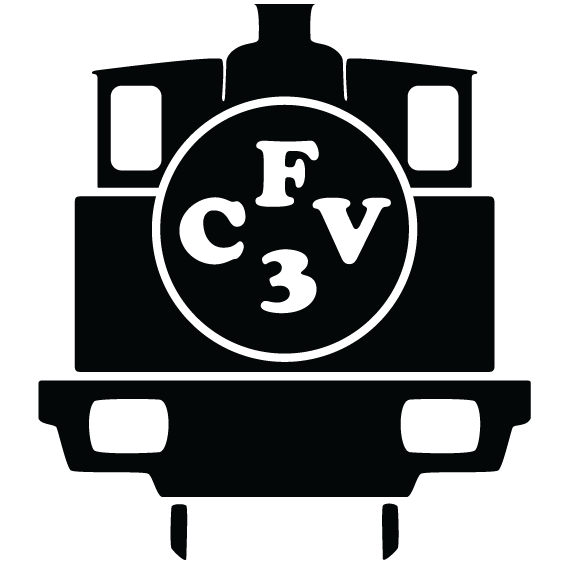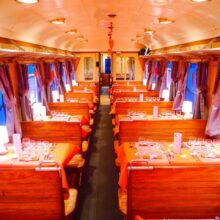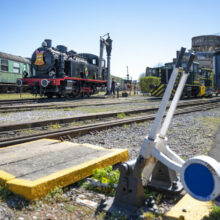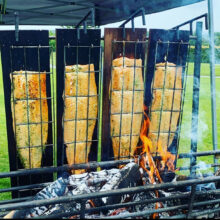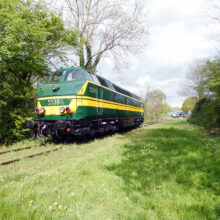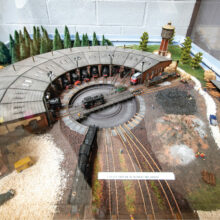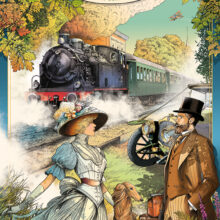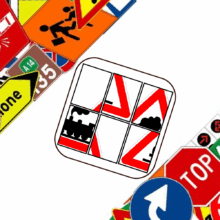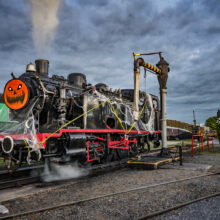Discover the history of the Chemin de Fer à Vapeur des Trois Vallées, its Museum & Line 132.
Browse the gallery of our railway equipment.
Histoire du CFV3V
Once upon a time … … … …
That’s how the stories of our childhood begin.
In 1973, a handful of steam-railway enthusiasts had the crazy dream of reviving a means of transport that had disappeared from the everyday scene 7 years earlier.
Today, this insane dream is shared by over 100 other lovers!
We’ve come a long way since then!
Birth of the CFV3V “Chemin de fer à Vapeur des 3 Vallées” (3 Valleys Steam Railway)
In the marvellous setting of the Trois Vallées, a handful of extraordinary collectors have made every modeler’s wildest dream come true: to bring the object of a passion to life in life-size!
The non-profit association Chemin de Fer à Vapeur des 3 Vallées was born of a crazy idea, an opportunity seized by the first president, Michel Pâques, in 1973.
In 1972, this SNCB driver was at the head of a passenger train bound for Brussels at Charleroi Sud station. To ease the wait caused by a stop signal, he was chatting from the top of his “loco” with a track worker. The conversation, as it should be between railway people, started off with questions of service and then moved on to other, less austere topics. He was surprised to learn that an old steam locomotive would soon be leaving the Pêchon colliery in Couillet and ending up with a local scrap dealer.
The opportunity.
Fascinated by railroads since childhood, he realized that luck was smiling on him, that a fleeting opportunity might enable him to realize a hitherto unattainable dream.
The very next day, he contacted the management of the colliery concerned, and in particular Jean Ghislain, Director of Works, and Raoul Manfroid, Senior Engineer at Monceau Fontaine. They explained to him that the locomotive was no longer used more than once a fortnight, and that other machines might be destined for demolition.
An appointment was made and some time later, Michel Pâques spent an unforgettable day at the controls of the machine. The machine’s usual driver, moved by this infatuation for the “old” steam engine, told him all its secrets, and told him its history… This was all it took for the enthusiastic SNCB driver to begin the long and tedious process. They lasted several months. Talks were held with both the collieries and the SNCB. He was warmly welcomed by many “old-timers”, for whom steam represented an entire era.
Tedious research.
The parties involved came to an agreement based on Michel Pâques’s idea: to revive a steam train on a standard gauge railroad line (the standard gauge is 1,435 m) for nostalgia buffs, but also for the younger generation.
Although this kind of attraction existed elsewhere, never before had a steam train been put back on wheels under real operating conditions, i.e. on regular gauge tracks.
After a long and arduous search, and with the help of the Commissariat Général au Tourisme and the Fédération du Tourisme de la province de Namur, Michel Pâques and a small group of friends reached the final stage of their investigations: to find a depot for the machines, as well as a track capable of accommodating them.
After a study by the SNCB, the choice was finally made for the Nismes – Treignes line (which later became Mariembourg – Treignes), some 14 kilometers of track winding through the wonderful Viroin valley.
Under the impetus of their Founding Chairman, a group of railwaymen and rail enthusiasts were able to realize an old dream: “to get steam trains running again in Belgium”.
Who are these volunteer members of CFV3V?
Of course, there are railwaymen, former steam traction operators now retired, as well as younger railwaymen who have heard so much about steam that they finally want to get to know this mythical mode of traction which was at the origin of the industrial revolution and the railroads. But they’re not alone: there’s also a majority of members who are railway enthusiasts, and who want to devote part of their leisure time to real operation. Without them, nothing would be possible. Apart from CFV3V, these members are students, teachers, engineers, fitters, turners, draughtsmen, clerks, policemen, mechanics, dental technicians, pharmacists, musicians, bus drivers and even priests and notaries! And let’s not forget the many wives who know how to make themselves useful.
All are employed according to their talents and aspirations, because at CFV3V you have to do it all: steam locomotive mechanics and drivers, drivers of railcars, locotractors or mainline diesel locomotives, shunters (to hook up carriages and wagons, ensure level-crossing protection), guards and stationmasters, mechanics to overhaul and maintain steam locomotives or diesel engines, carpenters, electricians, painters, coachbuilders, track layers, pickers, pruners, barmen and barwomen to run the refreshment bar, souvenir sellers, and we’re sure there are many more…
In the two years following publication of the association’s deed of incorporation in the Moniteur Belge (December 20, 1973), the association’s members set to work on tasks that were obscure (to the public) but necessary for operation, such as clearing overgrown vegetation from the line, the dismantling of points and rails and their reassembly in Mariembourg, the search for materials, contacts and negotiations with the SNCB, the Fédération du Tourisme de la province de Namur, the Commissariat Général au Tourisme and the municipal administrations of the entities crossed by the CFV3V line.
On May 14, 1975, an agreement was signed between the SNCB and the CFV3V, granting a 15-year concession to the a.s.b.l. Chemin de Fer à Vapeur des 3 Vallées, to operate the Nismes – Treignes section for tourist purposes. An amendment to this agreement was signed at the beginning of 1978, giving the CFV3V authorization to operate the Mariembourg – Nismes section (unused by the SNCB since October 12, 1977).
The CFV3V then had to build a boarding platform in Mariembourg, close to its depot.
As you read earlier, the CFV3V has taken on the legal status of an asbl (non-profit-making association). The management of this asbl is entrusted to a board of directors made up of around fifteen people. Under the authority of a chairman (Mr Didier Mosseray), the directors share the day-to-day management tasks. The directors are active members of the association.
Active members are all volunteers, and devote many hours of their leisure time to CFV3V.
Histoire du Musée
The Treignes museum
The Treignes railroad museum was inaugurated in 1994.
It took ten years for the idea launched by Roger Delizée, Member of Parliament, and Roger Maegerman, then President of CFV3V, to become a reality.
The museum displays the association’s collections on 4 tracks, each 105 meters long.
The CFV3V’s collections cover many aspects of the railroad. In the museum, you’ll find a superb Marklin “little train” layout that will delight young and old alike, as well as a superb stationary steam engine. You’ll also find a rich collection of lanterns and objects directly related to railway activity (old tools, scales, posters, etc.). A collection of caps representing a large number of railway companies from around the world, as well as a number of models in various scales, are also on display.
However, the bulk of the museum is made up of locomotives (steam, railcars, diesel and electric), carriages and wagons, most of which belong to the association.
While most of the exhibits belong to CFV3V members, others are the property of the SNCB or one of its “sister” associations. Many of the machines would need little work to be put back into service, while others are unfortunately permanently parked in the museum.
Histoire de la ligne 132
A brief history of the railroads in the region.
The idea of a railroad was first mooted in 1816, immediately after the fall of Napoleon and before Belgian independence. The idea, developed by a certain Thomas Gray (after whom the Rue Gray in Etterbeek is named) with John Cockerill, envisaged the creation of a (horse-drawn) railway to transport coal. Belgian in Holland. In the early 1830s, a number of railroads (still animal-drawn) were built either at the bottom of the collieries, or between the coal mining site and the nearest canal (Bois du Luc, Grand Hornu, Haut and Bas Flénu…). Around 1835, horse-drawn traction gave way to machines.
On May 5, 1835, Belgium inaugurated its first steam-powered passenger railroad between Brussels and Mechelen. While the first public railroad in Great Britain dates back to 1825, it was not until December 7, 1835, in Germany, 1837 in France, 1839 in the Netherlands and Italy.
As early as 1835, the Belgian government was considering the possibility of equipping the region between Sambre and Meuse with a railroad. In fact, the hilly, wooded region was rich in iron ore, quarries, slate quarries, sawmills and iron and steel industries. A railroad line transported these various products to Charleroi.
In April 1845, the public limited company “Chemin de fer de l’Entre Sambre et Meuse” was created under a concession system. A British company (W. P. Richards Co.) was awarded the contract. The company built and operated the railroad in the region, and the inauguration of new sections soon followed. The Charleroi – Walcourt line was inaugurated on November 27, 1848, the Walcourt – Silenrieux line on November 6, 1853, the Cerfontaine – Mariembourg line on June 8, 1854 and, finally, the section that interests us most directly: Mariembourg – Vireux, on June 15, 1854. At Vireux, line 148 (Brussels – Charleville) joined the French network.
In 1854, the Chemin de fer de l’Entre Sambre et Meuse merged with the Chemin de Fer de l’Anvers – Rotterdam. The new entity became known as the Grand Central Belge. On January 1, 1897, the Mariembourg – Vireux line was taken over by the Belgian state.
As Vireux was in France, a frontier station was set up in Vierves on land donated by the lord of Vierves. Treignes had only a simple stopover, and it was only later (1902) that a frontier station was built. As traffic grew, so did the facilities at Treignes station. At the time, the station had seven training tracks and a turntable. The station building is still impressive today, with its two-storey pavilions (housing upstairs and revenue and customs offices on the first floor). It bears witness to this prosperous period.
Around 1925, Chemins de fer de l’Etat Belge undertook the doubling of the entire Mariembourg Treignes line. Vestiges of this doubling of track are rare, but the bridge at the Olloy level crossing and the beginnings of a tunnel at Les Abannets are noteworthy… Now that nature has reclaimed its rights, the tunnel is lost in the vegetation.
The line we’re concerned with today is number 132 in the SNCB archives, and was operated as a passenger service until September 29, 1963. Freight service, which had remained on the Mariembourg – Nismes section, was completely discontinued on October 12, 1977. Only the Mariembourg – Nismes section was double-tracked.
From Mariembourg to Treignes – line 132 D.
Line 132, Mariembourg – Treignes runs through the Brouffe valleys, Eau Blanche, Eau Noire and Viroin. The name “Trois vallées” is linked to the last three rivers mentioned. The railroad passes through the villages of Nismes and Olloy sur Viroin, Vierves and Treignes.
This 14-kilometre-long railroad runs through the Viroin region, crossing three geographically distinct areas.
The Fagne (not to be confused with the Hautes Fagnes) is a large clay depression with a schist subsoil. This traditionally sparsely populated region is covered with forests and marshy meadows, and crops are fairly poor. Mariembourg lies in this region.
La Calestienne is the area crossed by the railroad between Mariembourg and Olloy. Between Olloy and Treignes, the track leaves the Calestienne on its left. The area is characterized by a succession of limestone ridges and valleys rich in silt deposits. The hills remained bare until the early 20th century, when they were used for grazing goats and sheep. The nature of the soil and the orientation of the hillsides create a warm, dry microclimate. A particularly rich flora and fauna can be found here. What’s more, the limestone nature of the soil has given rise to numerous cave-ins and caves. These caves have been inhabited since ancient times.
In the valleys, cereal farming has developed.
The presence of iron ore led to the development of the steel industry.
The Ardennes. The Ardennes massif is present here, south of the Meuse. The first foothills are visible south of the line from Olloy sur Viroin. (on the right towards Treignes). The region’s extensive forestry resources, mainly hardwoods, represent and have represented an important activity for the region. The exploitation of the forests provided the local population with a whole range of wood-related activities (furniture, carpentry, firewood, mining, clog making, cooperage, charcoal….).
If we take a closer look at the region and place it in a broader context, we can see that the Eau Blanche and Viroin area was an important economic axis a few decades ago. Not only was significant wealth exploited, but the valleys were also used to evacuate it. It’s hardly surprising, then, that the railroads came along and gave the region a major economic boost. As the riches were either exhausted or considered economically unprofitable, rail transport was abandoned. This communication corridor also aroused a certain amount of envy. During the 14-18 war, the railroad line provided easy access to Charleville and Verdun…
Mariembourg.
In 1546, under the reign of Marie de Hongrie, Charles V’s sister, a fortress was built and namedMariembourg. This lowland fortress protected Charles V’s southern Netherlands from France. Marie de Hongrie chose the Vérofle land for her construction project. From the 9th century onwards, the land belonged to various religious communities, including the Abbey of Lobbes, the Principality of Liège and the Norbertine Convent (Floreffe). In 1554, the fortress was conquered by Henri II of France and returned in 1559.
At the same time, the Château de Fagnolle was destroyed. This lowland castle is located just a few kilometers from the town, and a visit to its ruins is well worth the detour.
In 1659, Mariembourg became French again (Louis XIV – Treaty of the Pyrenees), and in 1815 became part of the Kingdom of the Netherlands. Belgian independence in 1830 restored the area to the Kingdom of Belgium.
A little anecdote: did you know that Mariembourg was the last Belgian town under Napoleonic administration after the Battle of Waterloo, and that Givet, just a few kilometers away (in France), held out for some time after Napoleon I’s abdication?
If you’re visiting Mariembourg, take a look at the street plan. They are laid out in a star shape around the main square, with a circular boulevard (the old fortifications) encircling the town. This layout is typically linked to the military history of the 16th century… it allowed cannons to be fired!
A typical piece of music remains from Louis XIV’s visit to the town, the branle de Mariembourg or danse du bouquet, performed in 1692. During the long French period (1659 – 1825), Mariembourg provided many soldiers, and the Napoleonic epic is still remembered.
In 1830, after the departure of the Dutch troops, the population wanted to be attached to France.
The fortifications were dismantled in 1855 (Fortress Convention – London 1831).
The town’s development was boosted by the creation of the railroad and the dismantling of the fortifications. Nearly 200 railway workers lived in the town during the heyday of the railways, and the settlement expanded, no longer confined by fortifications.
The station was an important rail hub, serving five lines: Charleroi, Hastière, Vireux (Reims – Charleville), Couvin and Chimay (Momignies – Anor). Today, the “RAVEL” has replaced the railway line between Mariembourg and Hastière.
Today, tourism is the town’s lifeblood….
CFV3V installations in Mariembourg.
The CFV3V installations are completely separate from those of the SNCB. Indeed, the different regulations do not allow joint operation on the SNCB station site.
The CFV3V facilities are easily accessible on foot from the SNCB station … but don’t follow the tracks!
The Mariembourg depot (LMG) is built of red brick, with a concrete roof. The depot’s architecture is rather unusual, as at Florennes, the building is in the form of a rotunda.
The Mariembourg roundhouse is the last in service, and houses some of the association’s equipment. Originally, 6 tracks were housed in this building. Today, 5 tracks are in service. Under track 2 is a pit for machine inspection and maintenance.
The rotunda was never served by a turntable. Triple needles were used to reach the various openings.
On the site, we find a water tower and a water crane in operation, used to supply steam locomotives. A second inspection pit is located next to the water crane.
Also nearby is the coal yard and a loading crane dating from 1910. Opposite the coal yard is the kindling reserve. On the other side of the SNCB tracks, we find a gatehouse, now privately owned.
Convoys depart from one of the loading bays. Finally, we find the reception building. And at the back of the rotunda, near the water tower, a large parking lot reserved for visitors.
From Mariembourg to Nismes.
This first section of the route is fairly short. The first road we cross leads to the RAVel track. This leads to Hastière on the site of the old railway line. We cross the Fagne and the first meadow on the right is called the “Prairie des Huttes”. In the 16th century, a plague epidemic devastated the region, and it was here that the huts for the sick were built. It was also here that corpses were burned.
The cult of Saint Roch, very present in the region, dates back to this period. Tradition has it that Saint Roch cured the sick until he caught the plague himself. He isolates himself in the forest, a dog comes to feed him, an angel comes to heal him and the saint is cured. This story explains why, throughout the region, the cult of Saint Roch is alive and well, and why there are so many chapels in which the saint is represented, accompanied by his dog. Let’s be indulgent: the same legend can be found elsewhere, particularly in France.
The railroad crosses the limestone strip at right angles, heading straight for the Roche à Lomme hill. At the foot of this rock, the Eau Noire and Eau Blanche rivers meet to form the Viroin. A short distance away, we reach Nismes, our first stopover.
To the left of the road is the “Montagne du Buis”. This was one of the first nature reserves created by Ardenne and Gaume in October 1947. These clumps of boxwood (buxaie), which grow on limestone slopes, are characteristic of the region’s vegetation. This sub-Mediterranean plant benefits from excellent exposure to the sun and finds its most northerly location here. Boxwoods combine with oaks to form extremely dense thickets in some places.
The dry lawns are home to a rare flower immortalized by the famous Belgian painter Redouté (born in Saint Hubert in 1759), the rose pimprenelle, also known as the “rosier de Mariembourg”.
Nismes.
Nismes railway station was built in 1868. This superb grey stone building is located just outside the village. The station building is now a private dwelling. Initially, the Dourbes road did not intersect the loading platform…. It was therefore not necessary to protect the level crossing. by a member brandishing a 21 (no crossing) disc, as is currently the case! currently!
Today, Nismes is the center of the Viroinval entity. The village is one of the oldest in the region. Traces of human occupation date back to 35,000 BC (Roche Trouée in Nismes, Trou des Blaireaux in Vaucelles, Trou de l’Abîme in Couvin). Some traces even go back 70,000 years! (Gimnée flint).
The earliest historical information we can rely on dates back to the 10th century, when Nismes belonged to the Abbey of Saint Germain des Prés. King Robert the Pious of France received the lands of Nismes (as well as those of Boussu, Couvin, Pesche and Frasnes) from this abbey. He subsequently endowed these lands to his sister Hedwige, who married Régnier IV de Hainaut. In 1096, Baudouin II de Hainaut sold these lands to the episcopate of Liège.
For over 3,000 years, the country’s prosperity has been linked to the iron and steel industry. Iron ore was plentiful and forests were abundant. In the 18th and 19th centuries, the iron and steel industry made the fortune of the Licot family. Their château, a converted former Cistercian convent, is now the seat of Viroinval’s municipal administration. The foundry was located at the far end of the château grounds and used ore extracted from Les Abannets and Les Fondrys.
The foundries also made use of the numerous waste products from Gallo-Roman foundries. This raw material was known as “Crayats de sarrasins”. In popular parlance, the nickname Crayats long referred to the inhabitants of Nismes.
With the decline of the low furnaces, the crayats were shipped to the Providence forges in Charleroi, of which Mr Licot was one of the founders.
The blast furnace site was transformed into a sawmill, which is still in operation today.
At the beginning of the 20th century, the clog-making industry took off in Nismes.
In Nismes, you should visit the Maladrerie farm, where in 1527 the plague victims were treated (Try Saint Roch), and the Maison des Baillis.
Another attraction is Fondry aux chiens, the spectacular site of a former iron ore mining operation.
From Nismes to Olloy sur Viroin.
We are now in the Viroin valley. We won’t leave this valley again until we reach the end of the line (Treignes).
Shortly after leaving the Nismes train station, we come across some very impressive industrial buildings. This is a former tannery (tannerie Houben). We’re at the foot of La Roche in Lomme.
The tannery, whose buildings are currently being restored (there are plans to make 16 apartments in them), had its heyday in the 19th century. At the time, tannin was extracted from the bark of the region’s numerous oak trees.
As for the “Roche à Lomme”, sometimes also spelt “Roche à l’Homme”, one might think it was a legend about a rider who fell from his mount. In fact, it was the southern boundary of the “Pagus Lommensis”. The Pays de Lomme took its name from the river of the same name, a tributary of the Lesse. The Lomme formed the north-eastern boundary of this “country”.
From the top of La Roche à Lomme we have a magnificent view of the region. The summit, now topped by a cross, has been occupied since Neolithic times. A square tower of Roman origin has long overlooked the site. A Roman garrison occupied the site, guarding the road from Saint Quentin through the Sambre-Meuse region.
Shortly after the tannery, the railroad enters the Abannets tunnel, almost 500 metres long. The Viroin bypasses the boulder and rejoins the railroad at the exit.
The name “Abannets” derives from the obsolete word “abannir”, to forbid. An edict issued by the Prince Bishop of Liège forbade cattle to graze in this hole-ridden area. One of the best-known “Abannets” is Fondry aux Chiens.
Shortly after the tunnel, we see a large quarry on our left. There are many shale, sandstone and limestone quarries in the region. Most of the houses in the area are built of local stone, grey and sometimes pink. Many of these quarries were used to build local homes.
Once past the quarry, the track crosses a level crossing (with automatic gates) cutting across the N99, to enter the station at Olloy sur Viroin. Shortly before the crossing, the train slows down considerably to control the crossing. A working pallet signal controls the crossing.
Olloy sur Viroin.
The Olloy sur Viroin railway station is currently owned by the Viroinval local authority. The building was fully restored in 2014. Various projects to do something with it are currently under study.
The station was built in 1901 in red brick, and boasts a superb glass roof to protect passengers on platform 1 from the elements. For many years, when the SNCB operated the line, the station was a prizewinner in the competition for the most beautiful stations in bloom. The station has been used as a film set on several occasions, including several episodes of “Maigret”.
At the station exit, a relatively old pallet signal is still in working order.
In 1909, Olloy was linked to Oignies en Thiérache by a local line. The Olloy station was used to exchange passengers or goods (slate, sandstone, wood) between the SNCB and SNCV networks.
In 2004, excavations were carried out in the commune and a protohistoric fortification was uncovered (Celtic period). Olloy was part of the Lordship of Hierges, vassal of the Duchy of Bouillon and the Principality of Liège. For a long time, forges and quarries provided work for the local population. Today, tourism is taking over.
From Olloy sur Viroin to Vierves.
Leaving the station, the line winds its way through the heart of the village, between the houses, next to the church (recently rebuilt) to reach the foot of the Rolinveaux hill. From Mariembourg to Treignes, the route is continuously downhill, with the exception of this hill. At the top of this little incline, we find an optional stop at a hotel restaurant. Just wave the red flag stuck in the fence!
Vierves.
The village of Vierves sur Viroin is listed in the inventory of the most beautiful villages in Wallonia.
The village is clustered around the majestic château. In the 15th century, the seigneury became a barony. To this day, the château retains the appearance it had in the 18th century, after being rebuilt following a fire.
The village is famous for its traditions. It is said that in the 12th century, Robert II de Vierves, jealous of the prosperity of the burgher Johan Simons, brought him to trial and had him burnt alive after being taken around the village.
This little episode in local life is repeated every year at Carnival!
Vierves is home to the Marie-Victorin center, whose activities focus on nature education.
The Vierves railway station, which was a frontier station for many years, lay derelict for some time. The building has recently been restored and is now home to the Centre Marie Victorin environmental lodge.
Did you know that along Route Nationale 99, we find a vineyard, producing a red wine?
From Vierves to Treignes.
The railway line winds along the Viroin in a beautiful valley, and we’re nearing the end of our journey.
Treignes.
For many years, the village of Treignes has been known as the “village of museums”. Here we find, among others
– musée du machinisme agricole
– musée du Malgré Tout
– écomusée
– musée du chemin de fer
Alongside these, we have the opportunity to visit the ruins of a Gallo-Roman villa, but above all, Treignes owes its fame to the character created by Arthur Masson: Toine Culot, maïeur de Trignolles. In the village’s main street, a site is dedicated to this Walloon character. Arthur Masson’s novel “Thanasse et Casimir” features Thanasse, a warden.
Treignes railway station.
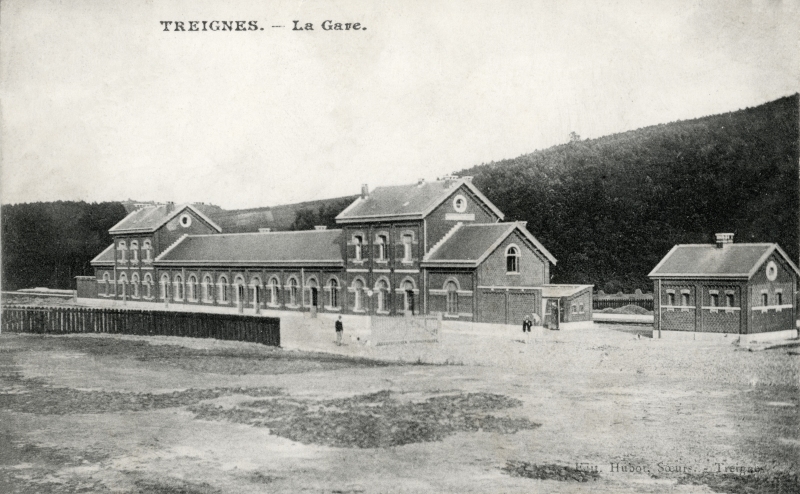
The Treignes railway station was acquired in 1972 by the Université Libre de Bruxelles to create an environmental laboratory for the study of the region’s aquatic and terrestrial fauna. We’ve described the building further on in this brochure.
When Treignes station still functioned as a frontier station, we found a few wooden watchtowers on the site. These helped customs officers to inspect convoys.
It’s no coincidence that one of the museums bears the pretty name of “Musée du Malgré-Tout”. The museum is located just a few hundred meters from the station.
CFV3V in Treignes.
A few steps from the station, you’ll see some large hangar-like buildings. This is one of CFV3V’s most important locations. These buildings house a museum, a cafeteria and, above all, a workshop.
We’ll talk about the museum a little later. In the cafeteria, our friendly staff will be delighted to welcome you. Now we’d like to talk about the workshop.
This is where the association’s acquisitions are maintained and restored. Two fairly long tracks (45 meters each) and an inspection pit enable members of the CFV3V and the Centre de Formation de Treignes (CFT) to carry out a wide range of work on locomotives, railcars, coaches and wagons.
A 20-ton overhead crane and several machine tools enable the association to repair and restore these vintage machines. It’s worth remembering that for these “old” machines, it’s often necessary to recreate certain parts from scratch. They are very rarely found on the market!
On the Treignes site, there are still some interesting parts to discover.
Firstly, opposite the station, towards the end of the site, there is a turntable. It runs on arm oil, so you can be sure that the volunteers to maneuver it are few and far between. For the more curious, traces of machine-gun fire from the Second World War can be seen in the bridge frame.
At the far end of the site, we also find a typical water tower. It’s not on the CFV3V site, but it adds to the railway atmosphere.
At the entrance to the site, we can see a control cabin which, at the time, was used to operate the needles present on the site.
On the site, too, you’ll notice two working paddlewheel signals and a water crane (on the quay) – it’s not connected. Next to the latter, the former lamp factory building now houses some of the exhibits belonging to the Museum of Rural Life.
